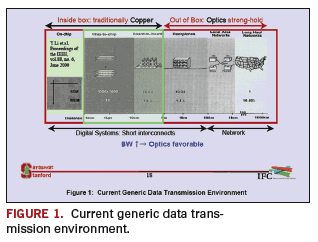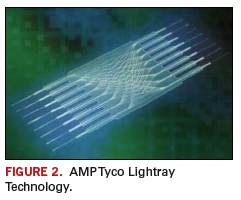Optical Waveguide PCB Interconnects

Optical technology continues to displace copper for for high-speed data transmission, but wide spread adaptation is still five years away.
Increased computing power is the primary driver in a move towards the optical interconnect.1 This drives miniaturization, high density circuits and high date rates resulting in a bottleneck at the electrical connections. Electrical (copper) interconnections, under these conditions, compromise performance and require increasing costs to shield and to condition signals to overcome electrical interconnection issues.
Optical technology generally continues to displace copper for data transmission over shorter distances. The higher the data rate required, the shorter the distance over which optical methods become superior. Telecommunications, from long haul down to the metro links, are a few kilometers in length and are dominated by single-mode optical technologies.
The Transition from Copper to an Optical Connection
FIGURE 1 is a graphic of the current generic data transmission environment with increasing distance horizontal and increasing bandwidth vertical.2 It illustrates the general state of optical methods replacing copper with optics and beginning to challenge copper in backplane applications.

TABLE 1 illustrates the battlefront between optical and copper data transmission in more detail by including specific distance-bandwidth combinations and an indication with $$ signs of the cost to fill the application utilizing copper methods.

The general consensus is that a copper pair is a viable media for transmitting up to 18 Gb/s over a maximum distance of one meter using conditioning/detection circuits. Whether or not copper can be used at greater bandwidth/distance combinations, marked as “Frontier” in this table, is an open issue.
Converting to optical methods at any of the frontiers can be an economic or technical issue, or both. At the longer distances, the issue is usually economic with optical innovation continually overcoming the economic barrier, resulting in adoption.
At the shorter distances, technology is not nearly as developed, and the economic issues are not yet clear, implying that it will be longer until those frontiers are overcome.
PCB Applications
As stated earlier, it is believed that copper can be used to transmit data at rates up to 18 Gb/s for distances up to one meter if signal-conditioning circuitry is used. Beyond that, the losses from the skin effect and dielectric loss tangent become too great to compensate. Optical methods may be viable and, indeed, have been used in a few specialized applications over the years. Optical backplanes, however, have not yet entered the mainstream and are not expected to do so in the near future.
FIGURE 2 shows an AMP Tyco, LIGHTRAY OFX, a flexible solution for precision fiber management in high fiber count telecommunications network equipment applications.
Designed using the latest fiber optic technology, LIGHTRAY OFX consists of a number of optical fibers encapsulated in thin protective film substrates. As well as saving valuable space in equipment and equipment racks, LIGHTRAY OFX also provides optimum optical performance. Optical fiber “crossovers” allow the optical fibers to be routed in both regular and irregular designs. Fibers are routed on 250 µm center lines.
The displacement of copper by optical technologies for data transmission continues. The growing demand for greater data transmission capacity, smaller physical size and lower power consumption generally favors optical methods and results in optical connections replacing copper connections as soon as the total cost of the optical solution is competitive. With the rising costs of energy and the power draw and data transmission rates increasing, optical technologies will continue to replace copper.
If we look at the use of optoelectronic technology across the spectrum, it might look something like:
- Massive use in long haul, metropolitan communications.
- Significant use in large LANs.
- Growing use within data centers for rack-to-rack data transfer.
- Copper OK to 20 Gbit up to one meter in backplanes.
- On circuit boards other than backplanes.
- Static; awaits need & demand.
- Much technology demonstrated but cost questionable.
- On-to and off-of chip.
- Exploring alternatives for lower power and more bandwidth.
- On-chip.
- Exploring alternatives for lower power and more bandwidth
- A modulated light source is needed.
Dr. Bruce Booth and I have discussed alternative waveguide manufacturing processes in detail in articles published in the March 2008 and April 2008 issues of PCD&F.3 Ridge technology and Diffusion technology are the two main types of processes, TABLE 2 compares these technologies. In the table, technology maturity is assigned for each of several technologies to be considered and includes important attributes using a scale of 1 to 4; namely:
- Literature, conceptual stage or early feasibility only.
- Laboratory demonstration, preliminary proof of concept, evaluation and testing.
- Prototypes constructed and delivered for evaluation, and/or demonstration or system design development, limited pilot production, initial application specific testing.
- Commercial product deployment, extensive testing, manufacturability demonstrated.
TABLE 3 discusses typical process characteristics of the different types of waveguides. The same maturity rating used in the previous table applies.
Needs and Showstoppers
What are the gaps and showstoppers for optoelectronic PCBs in production? We need a major OEM to say what its next generation of product X is going to be. Before committing resources to a technology, OEMs want to see the complete optical interconnect system demonstrated.
Besides having a good waveguide technology, OEMs are looking to facilitate a complete optical interconnection system from off-board to the chip level, between chips on multiple boards and back out off board.
- Capabilities for a complete optical interconnection system involve at least:
- Optical input and output connections at the edges of the motherboard or backplane.
- Right angle connectorization at the daughter board (DB) junction with the MB.
- Optical signal distribution on the DB or into Tx/Rx link packages.
These capabilities must be cost-competitive and low-risk versus electrical transmission. A low-cost, technically viable, modulated light source is also necessary.
There is another interesting difference between copper and optoelectronics having to do with standards. The PCB industry is structured on standards: design standards, manufacturing standards and testing standards. The optoelectronics industry is not this way; it is structured around Multi Source Agreements (MSAs). It’s not clear that this is a showstopper or just a mild bump in the road, but it will be interesting to follow as we go forth.
Conclusion
Optoelectronic technology is currently a mixed bag. If we look at optoelectronics by segment, generally using distance as criteria, we see the following segmentation.
Long Haul Telecom. These are now moving to higher speed transceivers from 1.5 Gb/s to 10 Gb/s. Some heavily used links move to multiple bits per symbol, implying complex digital signal processing. Dense wavelength division multiplexing is growing. Once a fiber is “provisioned,” meaning with multiplexers, demultiplexers and optical amplifiers, it is likely to be fully built out and utilized before another fiber is provisioned.
LANs. This segment is mostly datacom with people using Ethernet as a standard. Transceivers up to 10 Gbit are common. Some 4 Gbit transceivers are available but expensive and physically large.
From 1 Meter to 100 Meters. Plastic Optical fiber is growing in usage in this area, especially in automotive, and potentially aircraft applications. The attenuation of fluorinated POF is as low as 5 db/km and thus a candidate to replace glass in some applications. Multimode polymethymethacrylate POF offers low installation and assembly cost. Fiber can be cut with a razor blade like tool and simply inserted into connectors to form splices or interface to sources and detectors.
On-chip and Off-chip Up to 10 Meters. The frontier of optical methods replacing copper is on-to-chip and off-of-chip, with the leading edge being multicore microprocessors connected to memory with links of 1 meters to 10 meters.
1 Meter and Less. Backplane and circuit board applications still lack a good light source that works technically and is cost effective. Much effort is going into finding such a light source that, ideally, would be compatible with CMOS semiconductor manufacturing. Optoelectronic substrate connectivity is sufficiently advanced, practical and available today to be considered for some applications. The maturity of optical interconnectivity at the substrate level is sufficient to begin initial prototyping.
Practical multi-mode optical interconnection solutions using optical fiber and planar polymer waveguides are still being explored, developed and prototyped. A few years ago, the envisioned deployment was 2008/2009. Today, it appears that wide spread adaptation is still a few years off and that 2010 to 2015 might be closer to reality. PCD&F
REFERENCES
1. 2009 IPC International Technology Roadmap for Interconnections.
2. 2009 iNEMI Technology Roadmap.
3. Dr. Bruce L. Booth and Jack Fisher, “Optoelectronics Comes of Age”, Printed Circuit Design & Fab No. 2008 February and March.
CONTRIBUTORS
1. Dick Otte, President Promex, Inc. Santa Clara, CA.
2. Dr. Bruce L. Booth, President, Founder and CTO. of Optical InterLinks Inc.
Jack Fisher is a consultant with Interconnect Technology Analysis, Inc; This email address is being protected from spambots. You need JavaScript enabled to view it..




